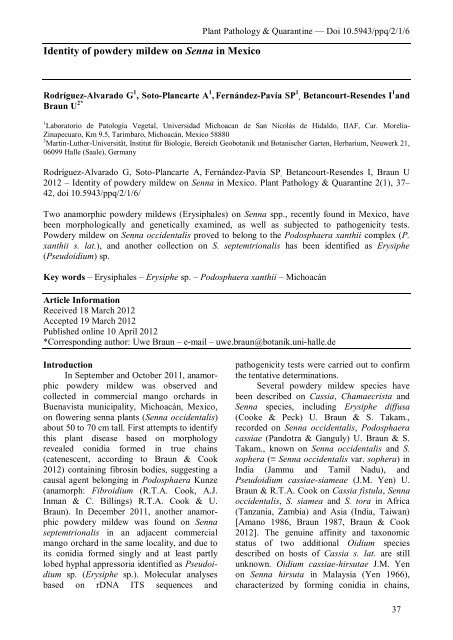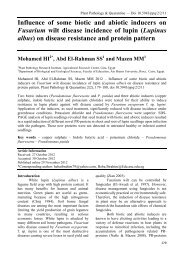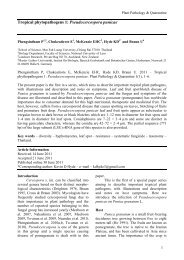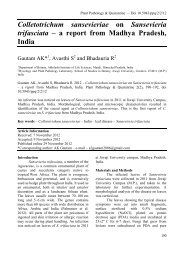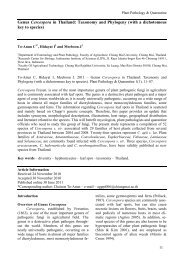Identity of powdery mildew on Senna in Mexico - Plant Pathology ...
Identity of powdery mildew on Senna in Mexico - Plant Pathology ...
Identity of powdery mildew on Senna in Mexico - Plant Pathology ...
Create successful ePaper yourself
Turn your PDF publications into a flip-book with our unique Google optimized e-Paper software.
<str<strong>on</strong>g>Identity</str<strong>on</strong>g> <str<strong>on</strong>g>of</str<strong>on</strong>g> <str<strong>on</strong>g>powdery</str<strong>on</strong>g> <str<strong>on</strong>g>mildew</str<strong>on</strong>g> <strong>on</strong> <strong>Senna</strong> <strong>in</strong> <strong>Mexico</strong><br />
<strong>Plant</strong> <strong>Pathology</strong> & Quarant<strong>in</strong>e — Doi 10.5943/ppq/2/1/6<br />
Rodríguez-Alvarado G 1 , Soto-Plancarte A 1 , Fernández-Pavía SP 1 , Betancourt-Resendes I 1 and<br />
Braun U 2*<br />
1 Laboratorio de Patología Vegetal, Universidad Michoacan de San Nicolás de Hidaldo, IIAF, Car. Morelia-<br />
Z<strong>in</strong>apecuaro, Km 9.5, Tarimbaro, Michoacán, <strong>Mexico</strong> 58880<br />
2 Mart<strong>in</strong>-Luther-Universität, Institut für Biologie, Bereich Geobotanik und Botanischer Garten, Herbarium, Neuwerk 21,<br />
06099 Halle (Saale), Germany<br />
Rodríguez-Alvarado G, Soto-Plancarte A, Fernández-Pavía SP , Betancourt-Resendes I, Braun U<br />
2012 – <str<strong>on</strong>g>Identity</str<strong>on</strong>g> <str<strong>on</strong>g>of</str<strong>on</strong>g> <str<strong>on</strong>g>powdery</str<strong>on</strong>g> <str<strong>on</strong>g>mildew</str<strong>on</strong>g> <strong>on</strong> <strong>Senna</strong> <strong>in</strong> <strong>Mexico</strong>. <strong>Plant</strong> <strong>Pathology</strong> & Quarant<strong>in</strong>e 2(1), 37–<br />
42, doi 10.5943/ppq/2/1/6/<br />
Two anamorphic <str<strong>on</strong>g>powdery</str<strong>on</strong>g> <str<strong>on</strong>g>mildew</str<strong>on</strong>g>s (Erysiphales) <strong>on</strong> <strong>Senna</strong> spp., recently found <strong>in</strong> <strong>Mexico</strong>, have<br />
been morphologically and genetically exam<strong>in</strong>ed, as well as subjected to pathogenicity tests.<br />
Powdery <str<strong>on</strong>g>mildew</str<strong>on</strong>g> <strong>on</strong> <strong>Senna</strong> occidentalis proved to bel<strong>on</strong>g to the Podosphaera xanthii complex (P.<br />
xanthii s. lat.), and another collecti<strong>on</strong> <strong>on</strong> S. septemtri<strong>on</strong>alis has been identified as Erysiphe<br />
(Pseudoidium) sp.<br />
Key words – Erysiphales – Erysiphe sp. – Podosphaera xanthii – Michoacán<br />
Article Informati<strong>on</strong><br />
Received 18 March 2012<br />
Accepted 19 March 2012<br />
Published <strong>on</strong>l<strong>in</strong>e 10 April 2012<br />
*Corresp<strong>on</strong>d<strong>in</strong>g author: Uwe Braun – e-mail – uwe.braun@botanik.uni-halle.de<br />
Introducti<strong>on</strong><br />
In September and October 2011, anamorphic<br />
<str<strong>on</strong>g>powdery</str<strong>on</strong>g> <str<strong>on</strong>g>mildew</str<strong>on</strong>g> was observed and<br />
collected <strong>in</strong> commercial mango orchards <strong>in</strong><br />
Buenavista municipality, Michoacán, <strong>Mexico</strong>,<br />
<strong>on</strong> flower<strong>in</strong>g senna plants (<strong>Senna</strong> occidentalis)<br />
about 50 to 70 cm tall. First attempts to identify<br />
this plant disease based <strong>on</strong> morphology<br />
revealed c<strong>on</strong>idia formed <strong>in</strong> true cha<strong>in</strong>s<br />
(catenescent, accord<strong>in</strong>g to Braun & Cook<br />
2012) c<strong>on</strong>ta<strong>in</strong><strong>in</strong>g fibros<strong>in</strong> bodies, suggest<strong>in</strong>g a<br />
causal agent bel<strong>on</strong>g<strong>in</strong>g <strong>in</strong> Podosphaera Kunze<br />
(anamorph: Fibroidium (R.T.A. Cook, A.J.<br />
Inman & C. Bill<strong>in</strong>gs) R.T.A. Cook & U.<br />
Braun). In December 2011, another anamorphic<br />
<str<strong>on</strong>g>powdery</str<strong>on</strong>g> <str<strong>on</strong>g>mildew</str<strong>on</strong>g> was found <strong>on</strong> <strong>Senna</strong><br />
septemtri<strong>on</strong>alis <strong>in</strong> an adjacent commercial<br />
mango orchard <strong>in</strong> the same locality, and due to<br />
its c<strong>on</strong>idia formed s<strong>in</strong>gly and at least partly<br />
lobed hyphal appressoria identified as Pseudoidium<br />
sp. (Erysiphe sp.). Molecular analyses<br />
based <strong>on</strong> rDNA ITS sequences and<br />
pathogenicity tests were carried out to c<strong>on</strong>firm<br />
the tentative determ<strong>in</strong>ati<strong>on</strong>s.<br />
Several <str<strong>on</strong>g>powdery</str<strong>on</strong>g> <str<strong>on</strong>g>mildew</str<strong>on</strong>g> species have<br />
been described <strong>on</strong> Cassia, Chamaecrista and<br />
<strong>Senna</strong> species, <strong>in</strong>clud<strong>in</strong>g Erysiphe diffusa<br />
(Cooke & Peck) U. Braun & S. Takam.,<br />
recorded <strong>on</strong> <strong>Senna</strong> occidentalis, Podosphaera<br />
cassiae (Pandotra & Ganguly) U. Braun & S.<br />
Takam., known <strong>on</strong> <strong>Senna</strong> occidentalis and S.<br />
sophera (≡ <strong>Senna</strong> occidentalis var. sophera) <strong>in</strong><br />
India (Jammu and Tamil Nadu), and<br />
Pseudoidium cassiae-siameae (J.M. Yen) U.<br />
Braun & R.T.A. Cook <strong>on</strong> Cassia fistula, <strong>Senna</strong><br />
occidentalis, S. siamea and S. tora <strong>in</strong> Africa<br />
(Tanzania, Zambia) and Asia (India, Taiwan)<br />
[Amano 1986, Braun 1987, Braun & Cook<br />
2012]. The genu<strong>in</strong>e aff<strong>in</strong>ity and tax<strong>on</strong>omic<br />
status <str<strong>on</strong>g>of</str<strong>on</strong>g> two additi<strong>on</strong>al Oidium species<br />
described <strong>on</strong> hosts <str<strong>on</strong>g>of</str<strong>on</strong>g> Cassia s. lat. are still<br />
unknown. Oidium cassiae-hirsutae J.M. Yen<br />
<strong>on</strong> <strong>Senna</strong> hirsuta <strong>in</strong> Malaysia (Yen 1966),<br />
characterized by form<strong>in</strong>g c<strong>on</strong>idia <strong>in</strong> cha<strong>in</strong>s,<br />
37
<strong>Plant</strong> <strong>Pathology</strong> & Quarant<strong>in</strong>e — Doi 10.5943/ppq/2/1/6<br />
might be a syn<strong>on</strong>ym <str<strong>on</strong>g>of</str<strong>on</strong>g> Podosphaera cassiae,<br />
but absence or occurrence <str<strong>on</strong>g>of</str<strong>on</strong>g> fibros<strong>in</strong> bodies<br />
was not menti<strong>on</strong>ed <strong>in</strong> the orig<strong>in</strong>al descripti<strong>on</strong>,<br />
and the c<strong>on</strong>idia were described to be up to 56.5<br />
× 27.5 µm <strong>in</strong> size. Type material <str<strong>on</strong>g>of</str<strong>on</strong>g> this species<br />
was not available for re-exam<strong>in</strong>ati<strong>on</strong>. Oidium<br />
cassiae-leschenaultianae N. Ahmad, A.K.<br />
Sarbhoy, Kamal & D.K. Agarwal (Ahmad et<br />
al. 2007) <strong>on</strong> Chamaecrista leschenaultiana (≡<br />
Cassia leschenaultiana) <strong>in</strong> India (Uttar<br />
Pradesh) is an <strong>in</strong>sufficiently known, doubtful<br />
species. The broad and l<strong>on</strong>g c<strong>on</strong>idiophores, the<br />
c<strong>on</strong>idial size and germ tubes at least partly<br />
aris<strong>in</strong>g from a side rather suggest a species <str<strong>on</strong>g>of</str<strong>on</strong>g><br />
Podosphaera sect. Sphaerotheca (Lév.) de<br />
Bary or Golov<strong>in</strong>omyces sect. Depressi (U.<br />
Braun) U. Braun, but <strong>in</strong> the orig<strong>in</strong>al descripti<strong>on</strong><br />
the c<strong>on</strong>idia were described as be<strong>in</strong>g formed<br />
s<strong>in</strong>gly and fibros<strong>in</strong> bodies were not menti<strong>on</strong>ed<br />
(Ahmad et al. 2007, Braun & Cook 2012).<br />
Methods<br />
The collecti<strong>on</strong>s exam<strong>in</strong>ed were mounted<br />
<strong>in</strong> distilled water when fresh or lactic acid and<br />
gently heated when dry, us<strong>in</strong>g oil immersi<strong>on</strong><br />
(bright field and phase c<strong>on</strong>trast), but without<br />
any sta<strong>in</strong><strong>in</strong>g, and then exam<strong>in</strong>ed by means <str<strong>on</strong>g>of</str<strong>on</strong>g><br />
standard light microscopy (Olympus BX 50,<br />
Hamburg, Germany). 30 measurements (<br />
1000 magnificati<strong>on</strong>) <str<strong>on</strong>g>of</str<strong>on</strong>g> c<strong>on</strong>idia and other<br />
structures were made, with the extremes given<br />
<strong>in</strong> parentheses.<br />
<strong>Senna</strong> seeds were collected <strong>in</strong> a <str<strong>on</strong>g>powdery</str<strong>on</strong>g><br />
<str<strong>on</strong>g>mildew</str<strong>on</strong>g> disease free area and planted <strong>on</strong> peat<br />
moss substrate to obta<strong>in</strong> healthy plants.<br />
Pathogenicity tests were carried out with four<br />
m<strong>on</strong>th old <strong>Senna</strong> occidentalis plants dur<strong>in</strong>g<br />
October 2011. Inoculati<strong>on</strong> was performed by<br />
plac<strong>in</strong>g <strong>in</strong>fected leaves collected <strong>in</strong> the field <strong>on</strong><br />
leaves <str<strong>on</strong>g>of</str<strong>on</strong>g> healthy plants previously sprayed<br />
with water. C<strong>on</strong>trol plants were not <strong>in</strong>oculated.<br />
Inoculated plants were covered with plastic<br />
bags for 24 hours, all plants were placed<br />
together.<br />
DNA extracti<strong>on</strong> from <str<strong>on</strong>g>powdery</str<strong>on</strong>g> <strong>in</strong>fected<br />
leaves was d<strong>on</strong>e by us<strong>in</strong>g a Wizard Genomic<br />
DNA Purificati<strong>on</strong> Kit (Promega Corp.,<br />
Madis<strong>on</strong>, Wisc<strong>on</strong>s<strong>in</strong>) follow<strong>in</strong>g the <strong>in</strong>structi<strong>on</strong>s<br />
provided by the manufacturer. Amplificati<strong>on</strong> <str<strong>on</strong>g>of</str<strong>on</strong>g><br />
the <strong>in</strong>ternal transcribed spacer (ITS) regi<strong>on</strong><br />
<strong>in</strong>clud<strong>in</strong>g 5.8S rDNA, the 3' end <str<strong>on</strong>g>of</str<strong>on</strong>g> 18S rDNA<br />
and the 5' end <str<strong>on</strong>g>of</str<strong>on</strong>g> 28S rDNA <strong>in</strong>clud<strong>in</strong>g the<br />
variable doma<strong>in</strong>s D1 and D2, followed<br />
standard methods as outl<strong>in</strong>ed <strong>in</strong> Cunn<strong>in</strong>gt<strong>on</strong> et<br />
al. (2003). PCR reacti<strong>on</strong>s were c<strong>on</strong>ducted with<br />
HotStarTaq DNA polymerase (HotStarTaq<br />
Master Mix Kit, Qiagen, Valencia, CA) <strong>in</strong> a<br />
thermal cycler (Mastercycler Gradient,<br />
Eppendorf). The PCR reacti<strong>on</strong>s were cleaned<br />
us<strong>in</strong>g a Wizard SV Gel and PCR Clean-up<br />
System (Promega, Corp., Madis<strong>on</strong>, Wisc<strong>on</strong>s<strong>in</strong>)<br />
follow<strong>in</strong>g the manufacturer’s protocol. PCR<br />
products were visualized by electrophoresis <strong>in</strong><br />
1.5% agarose gel <strong>in</strong> TAE buffer. Nucleotide<br />
sequences <str<strong>on</strong>g>of</str<strong>on</strong>g> the PCR products were obta<strong>in</strong>ed<br />
us<strong>in</strong>g direct sequenc<strong>in</strong>g by an external<br />
company (Macrogen Inc. Soul, Korea). For<br />
amplificati<strong>on</strong> <str<strong>on</strong>g>of</str<strong>on</strong>g> the ITS regi<strong>on</strong>, primers ITS5<br />
and ITS4 (White et al. 1990) were used.<br />
C<strong>on</strong>sensus sequences for the amplified regi<strong>on</strong><br />
from each isolated were obta<strong>in</strong>ed us<strong>in</strong>g Pregap<br />
and Gap <strong>in</strong> the Staden Package<br />
(http://staden.sourceforge.net). Sequences were<br />
deposited <strong>in</strong> GenBank; 673 bp for Podosphaera<br />
xanthii <strong>on</strong> <strong>Senna</strong> occidentalis<br />
(JQ728480) and 755 bp for the anamorph <strong>on</strong> S.<br />
septemtri<strong>on</strong>alis (JQ730709). Obta<strong>in</strong>ed sequences<br />
were used <strong>in</strong> the BLASTN 2.2.25+<br />
program (http://www.ncbi.nlm.nih.gov/) to<br />
determ<strong>in</strong>e tax<strong>on</strong> identity based <strong>on</strong> similarity<br />
between sequences expressed as percent<br />
sequence identity. Sequences were analyzed<br />
phylogenetically us<strong>in</strong>g Mega versi<strong>on</strong> 5.0.<br />
Initially, the sequences were aligned us<strong>in</strong>g<br />
ClustalW. Phylogenetic trees were obta<strong>in</strong>ed<br />
from the data by the neighbour-jo<strong>in</strong><strong>in</strong>g method<br />
with Tajima-Nei distance calculati<strong>on</strong>, but they<br />
are not shown <strong>in</strong> this paper.<br />
Results and Discussi<strong>on</strong><br />
Podosphaera xanthii (Castagne) U. Braun &<br />
Shishk<str<strong>on</strong>g>of</str<strong>on</strong>g>f, Schlechtendalia 4: 31, 2000 (sensu<br />
Braun & Cook 2012). Fig. 1<br />
Mycelium <strong>on</strong> leaves, amphigenous, but<br />
ma<strong>in</strong>ly epiphyllous, form<strong>in</strong>g th<strong>in</strong> white<br />
patches, subcircular to irregular, later c<strong>on</strong>fluent;<br />
hyphae branched, septate, th<strong>in</strong>-walled,<br />
smooth, hyphal cells 50–90 µm l<strong>on</strong>g and (3–<br />
)4–7(–8) µm wide, straight to s<strong>in</strong>uous, sometimes<br />
somewhat geniculate; hyphal appressoria<br />
<strong>in</strong>dist<strong>in</strong>ct to somewhat nipple-shaped; c<strong>on</strong>idiophores<br />
aris<strong>in</strong>g ± centrally or usually laterally<br />
from the upper surface <str<strong>on</strong>g>of</str<strong>on</strong>g> the mother<br />
38
<strong>Plant</strong> <strong>Pathology</strong> & Quarant<strong>in</strong>e — Doi 10.5943/ppq/2/1/6<br />
Fig. 1 – Podosphaera xanthii, symptoms (mycelium col<strong>on</strong>ies) <strong>on</strong> <strong>Senna</strong> occidentialis, photo based<br />
<strong>on</strong> a potted plant from pathogenicity test. – Bar = 1 cm. This picture is copyright <str<strong>on</strong>g>of</str<strong>on</strong>g> SP Fernández-<br />
Pavía.<br />
cell, erect, about 120–300 µm l<strong>on</strong>g (with<br />
c<strong>on</strong>idia), foot-cells straight, subcyl<strong>in</strong>drical,<br />
(30–)40–65 × 9–12 µm, followed by 1–5<br />
shorter cells; c<strong>on</strong>idia formed <strong>in</strong> cha<strong>in</strong>s with<br />
crenulate outl<strong>in</strong>e, broadly obovoid (primary<br />
c<strong>on</strong>idia) to ellipsoid-doliiform, (20–)25–35(–<br />
37) × 14–20 µm, length/width ratio 1.3–1.9,<br />
ends rounded to subtruncate, with c<strong>on</strong>spicuous<br />
fibros<strong>in</strong> bodies.<br />
Material exam<strong>in</strong>ed: MEXICO, Michoacán,<br />
Buenavista municipality, commercial<br />
mango orchards, <strong>on</strong> leaves <str<strong>on</strong>g>of</str<strong>on</strong>g> <strong>Senna</strong> occidentalis<br />
(Fabaceae, Caesalp<strong>in</strong>ioideae), 28 September<br />
2011, SP Fernandez-Pavia [material<br />
from pathogenicity tests] (HAL 2457 F).<br />
Based <strong>on</strong> c<strong>on</strong>idia with fibros<strong>in</strong> bodies<br />
formed <strong>in</strong> genu<strong>in</strong>e cha<strong>in</strong>s and <strong>in</strong>dist<strong>in</strong>ct to<br />
nipple-shaped hyphal appressoria, the <str<strong>on</strong>g>powdery</str<strong>on</strong>g><br />
<str<strong>on</strong>g>mildew</str<strong>on</strong>g> anamorph found <strong>on</strong> <strong>Senna</strong> occidentalis<br />
<strong>in</strong> <strong>Mexico</strong> can be unambiguously referred to<br />
the genus Podosphaera (Braun & Cook 2012),<br />
which has been additi<strong>on</strong>ally proven by molecular<br />
sequence analyses. A blast search based<br />
<strong>on</strong> the sequence retrieved from <str<strong>on</strong>g>powdery</str<strong>on</strong>g><br />
<str<strong>on</strong>g>mildew</str<strong>on</strong>g> <strong>on</strong> this host showed a close similarity<br />
or identity with other sequences <str<strong>on</strong>g>of</str<strong>on</strong>g> species <str<strong>on</strong>g>of</str<strong>on</strong>g><br />
Podosphaera sect. Sphaerotheca subsect.<br />
Magnicellulatae (U. Braun) U. Braun & S.<br />
Takam. The follow<strong>in</strong>g deposited sequences<br />
have a co<strong>in</strong>cidence <str<strong>on</strong>g>of</str<strong>on</strong>g> 100%: GQ927253.1<br />
(deposited as Podosphaera phaseoli (Z.Y.<br />
Zhao) U. Braun & S. Takam., obta<strong>in</strong>ed from<br />
material <strong>on</strong> Vigna unguiculata, Ch<strong>in</strong>a),<br />
FJ625796.1 (as P. balsam<strong>in</strong>ae (Wallr.) U.<br />
Braun & S. Takam., obta<strong>in</strong>ed from material <strong>on</strong><br />
Impatiens balsam<strong>in</strong>a, Ch<strong>in</strong>a), AF011319.1 (as<br />
Sphaerotheca fusca (Fr.) U. Braun &<br />
Shishk<str<strong>on</strong>g>of</str<strong>on</strong>g>f, obta<strong>in</strong>ed from material <strong>on</strong> Cucurbita<br />
pepo, USA, California), AB046985.1 (as P.<br />
xanthii, obta<strong>in</strong>ed from material <strong>on</strong> Verbena<br />
×hybrida from the USA, New York) and<br />
AB040339.1 (as Podosphaera sp., obta<strong>in</strong>ed<br />
from material <strong>on</strong> Sa<strong>in</strong>tpaulia sp. from<br />
Australia). Additi<strong>on</strong>al sequences agree with<br />
99%: AB040318.1 (as P. balsam<strong>in</strong>ae, obta<strong>in</strong>ed<br />
from material <strong>on</strong> Impatiens noli-tangere from<br />
Japan), AB525914.1 (as P. fusca, obta<strong>in</strong>ed<br />
from material <strong>on</strong> Calendula <str<strong>on</strong>g>of</str<strong>on</strong>g>fic<strong>in</strong>alis,<br />
Argent<strong>in</strong>a), AB040320.1 (as P. pseud<str<strong>on</strong>g>of</str<strong>on</strong>g>usca<br />
(U. Braun) U. Braun & S. Takam., obta<strong>in</strong>ed<br />
from material <strong>on</strong> Fatoua villosa, Japan),<br />
EF050036.1 (as P. xanthii, obta<strong>in</strong>ed from<br />
material <strong>on</strong> Physalis angulata, Taiwan),<br />
AB040308.1 (as Podosphaera sp., obta<strong>in</strong>ed<br />
from material <strong>on</strong> Hibiscus mutabilis from<br />
Japan).<br />
39
<strong>Plant</strong> <strong>Pathology</strong> & Quarant<strong>in</strong>e — Doi 10.5943/ppq/2/1/6<br />
All sequences with a co<strong>in</strong>cidence <str<strong>on</strong>g>of</str<strong>on</strong>g><br />
100% bel<strong>on</strong>g to Podosphaera xanthii as<br />
recently circumscribed by Braun & Cook<br />
(2012), who revised the whole complex <str<strong>on</strong>g>of</str<strong>on</strong>g><br />
Podosphaera sect. Sphaerotheca subsect. Magnicellulatae.<br />
P. xanthii is characterized by<br />
hav<strong>in</strong>g large chasmothecia, about 80–110 µm<br />
diam., and asci with large term<strong>in</strong>al oculi,<br />
usually 15–25 µm diam., and is known to be<br />
pathogenic <strong>on</strong> a wide range <str<strong>on</strong>g>of</str<strong>on</strong>g> hosts bel<strong>on</strong>g<strong>in</strong>g<br />
to different plant families. Plurivorous races,<br />
able to <strong>in</strong>fect a wider range <str<strong>on</strong>g>of</str<strong>on</strong>g> hosts, are<br />
<strong>in</strong>volved. Podosphaera phaseoli has been<br />
reduced to syn<strong>on</strong>ym with P. xanthii (Braun &<br />
Cook 2012), and Podosphaera <strong>on</strong> Impatiens<br />
balsam<strong>in</strong>a bel<strong>on</strong>gs to P. xanthii as well, i.e. it<br />
is not c<strong>on</strong>specific with P. balsam<strong>in</strong>ae which is<br />
c<strong>on</strong>f<strong>in</strong>ed to Impatiens noli-tangere ma<strong>in</strong>ly <strong>in</strong><br />
Europe (Ito & Takamatsu 2010, Braun & Cook<br />
2012). The name Sphaerotheca fusca (Fr.) S.<br />
Blumer ( Podosphaera fusca) has previously<br />
been applied <strong>in</strong> a very broad sense, <strong>in</strong>clud<strong>in</strong>g<br />
the current P. xanthii (Braun 1987). The true P.<br />
fusca is, however, c<strong>on</strong>f<strong>in</strong>ed to Dor<strong>on</strong>icum<br />
species as hosts and characterized by hav<strong>in</strong>g<br />
small chasmothecia, 65–90 µm diam., with<br />
very l<strong>on</strong>g appendages, asci with small term<strong>in</strong>al<br />
oculi, diameter 15 µm, and forms brown<br />
sec<strong>on</strong>dary mycelium (Braun & Cook 2012).<br />
The results <str<strong>on</strong>g>of</str<strong>on</strong>g> sequence analyses <strong>in</strong>dicate<br />
that the Mexican <strong>Senna</strong> occidentalis <str<strong>on</strong>g>powdery</str<strong>on</strong>g><br />
<str<strong>on</strong>g>mildew</str<strong>on</strong>g> bel<strong>on</strong>gs to P. xanthii. The <strong>in</strong>fecti<strong>on</strong> has<br />
probably been caused by a plurivorous race <str<strong>on</strong>g>of</str<strong>on</strong>g><br />
this species. The identificati<strong>on</strong> <str<strong>on</strong>g>of</str<strong>on</strong>g> this <str<strong>on</strong>g>powdery</str<strong>on</strong>g><br />
<str<strong>on</strong>g>mildew</str<strong>on</strong>g> is supported by the morphology <str<strong>on</strong>g>of</str<strong>on</strong>g> its<br />
anamorph, which agrees perfectly with<br />
characteristics <str<strong>on</strong>g>of</str<strong>on</strong>g> c<strong>on</strong>idial states <str<strong>on</strong>g>of</str<strong>on</strong>g> the latter<br />
species. However, anamorphs <str<strong>on</strong>g>of</str<strong>on</strong>g> species with<strong>in</strong><br />
Podosphaera sect. Sphaerotheca subsect.<br />
Magnicellulatae are little differentiated and<br />
usually not dist<strong>in</strong>ctive. The anamorph <str<strong>on</strong>g>of</str<strong>on</strong>g> the<br />
Indian Podosphaera cassiae (Braun 1987,<br />
Braun & Cook 2012) is very similar, but<br />
without sequence data retrieved from Asian<br />
samples <str<strong>on</strong>g>of</str<strong>on</strong>g> the latter species, it is not yet<br />
possible to elucidate relati<strong>on</strong>s between the two<br />
species.<br />
Pathogenicity tests were carried out with<br />
four m<strong>on</strong>th old senna plants dur<strong>in</strong>g October.<br />
Inoculati<strong>on</strong> was performed by plac<strong>in</strong>g <strong>in</strong>fected<br />
leaves collected <strong>in</strong> the field <strong>on</strong> leaves <str<strong>on</strong>g>of</str<strong>on</strong>g><br />
healthy plants previously sprayed with water.<br />
C<strong>on</strong>trol plants were not <strong>in</strong>oculated. Inoculated<br />
plants were covered with plastic bags for 24<br />
hours. Powdery <str<strong>on</strong>g>mildew</str<strong>on</strong>g> symptoms began to<br />
develop eight days after <strong>in</strong>oculati<strong>on</strong>. All leaves<br />
were covered with mycelium, c<strong>on</strong>idia were<br />
formed 18 days after <strong>in</strong>oculati<strong>on</strong>, and<br />
defoliati<strong>on</strong> was observed after <strong>on</strong>e m<strong>on</strong>th.<br />
N<strong>on</strong>-<strong>in</strong>oculated plants rema<strong>in</strong>ed healthy<br />
throughout the experiment.<br />
Erysiphe sp. (Pseudoidium sp.) Fig. 2<br />
Mycelium amphigenous, ma<strong>in</strong>ly epiphyllous,<br />
effuse or <strong>in</strong> irregular th<strong>in</strong> patches,<br />
white to grayish white; hyphae straight to<br />
somewhat flexuous, branched at ± right angles,<br />
septate, th<strong>in</strong>-walled, hyal<strong>in</strong>e, smooth, 2.5–8 µm<br />
wide; hyphal appressoria spar<strong>in</strong>gly developed,<br />
almost nipple-shaped to lobed, 3–6 µm diam.;<br />
c<strong>on</strong>idiophores aris<strong>in</strong>g ± centrally to laterally<br />
from the upper surface <str<strong>on</strong>g>of</str<strong>on</strong>g> mother cells, erect,<br />
about 20–60 µm l<strong>on</strong>g, width somewhat<br />
<strong>in</strong>creas<strong>in</strong>g from base to top, basal septum at the<br />
juncti<strong>on</strong> with the support<strong>in</strong>g hypha or <strong>on</strong>ly<br />
slightly elevated (up to 5 µm), foot-cells<br />
straight, occasi<strong>on</strong>ally slightly curved-s<strong>in</strong>uous,<br />
subcyl<strong>in</strong>drical, 14–30 × 6–9 µm, followed by<br />
1–2 cells that are shorter than the foot-cells,<br />
about as l<strong>on</strong>g or somewhat l<strong>on</strong>ger, follow<strong>in</strong>g<br />
cells about as wide as the foot-cells or <str<strong>on</strong>g>of</str<strong>on</strong>g>ten<br />
somewhat wider, 8–12 µm, form<strong>in</strong>g c<strong>on</strong>idia<br />
s<strong>in</strong>gly; c<strong>on</strong>idia ellipsoid-ovoid, subcyl<strong>in</strong>dricaldoliiform,<br />
22–38 × 14–20 µm, apex <str<strong>on</strong>g>of</str<strong>on</strong>g> primary<br />
c<strong>on</strong>idia rounded, subtruncate <strong>in</strong> sec<strong>on</strong>dary<br />
c<strong>on</strong>idia, base always truncate or subtruncate.<br />
Material exam<strong>in</strong>ed: MEXICO, Michoacán,<br />
Buenavista municipality, commercial<br />
mango orchards, <strong>on</strong> leaves <str<strong>on</strong>g>of</str<strong>on</strong>g> <strong>Senna</strong><br />
septemtri<strong>on</strong>alis (Fabaceae, Caesalp<strong>in</strong>ioideae),<br />
12 December 2011, SP Fernandez-Pavia (HAL<br />
2478 F).<br />
Symptoms and micro-morphological<br />
characters <str<strong>on</strong>g>of</str<strong>on</strong>g> Mexican specimens <strong>on</strong> <strong>Senna</strong><br />
septemtri<strong>on</strong>alis resemble those <str<strong>on</strong>g>of</str<strong>on</strong>g> the ma<strong>in</strong>ly<br />
North to South American Erysiphe diffusa, but<br />
the anamorph <str<strong>on</strong>g>of</str<strong>on</strong>g> the latter species is still<br />
<strong>in</strong>sufficiently known (Braun & Cook 2012).<br />
Furthermore, E. diffusa is undoubtedly heterogeneous<br />
and represents a complex <str<strong>on</strong>g>of</str<strong>on</strong>g> different<br />
races or even cryptic species. The Mexican<br />
samples <strong>on</strong> S. septemtri<strong>on</strong>alis differ from the<br />
anamorph <str<strong>on</strong>g>of</str<strong>on</strong>g> E. diffusa <strong>in</strong> hav<strong>in</strong>g dist<strong>in</strong>ct<br />
arrangements <str<strong>on</strong>g>of</str<strong>on</strong>g> c<strong>on</strong>idiophore cells (<strong>in</strong><br />
40
<strong>Plant</strong> <strong>Pathology</strong> & Quarant<strong>in</strong>e — Doi 10.5943/ppq/2/1/6<br />
Fig. 2 – Erysiphe sp (Pseudoidium sp.) <strong>on</strong> <strong>Senna</strong> septemtri<strong>on</strong>alis, based <strong>on</strong> HAL 2478 F. a<br />
Appressoria. b C<strong>on</strong>idiophores. c C<strong>on</strong>idia. – Bar = 10 µm. U. Braun del.<br />
the latter species foot-cells are followed by<br />
shorter cells) and rather short c<strong>on</strong>idiophores<br />
mostly dist<strong>in</strong>ctly <strong>in</strong>creas<strong>in</strong>g <strong>in</strong> width from base<br />
to top (<strong>in</strong> E. diffusa l<strong>on</strong>ger subcyl<strong>in</strong>drical<br />
c<strong>on</strong>idiophores). Pseudoidium cassiae-siameae<br />
(≡ Oidium cassiae-siameae J.M. Yen, = O.<br />
cassiae-torae N. Ahmad, A.K. Sarbhoy, Kamal<br />
& D.K. Agarwal), which is known from Africa<br />
and Asia <strong>on</strong> Cassia and <strong>Senna</strong> spp. (Braun<br />
1987, Ahmad et al. 2007, Hosagoudar and<br />
Agarwal 2009, Braun & Cook 2012), is similar,<br />
but differs <strong>in</strong> hav<strong>in</strong>g much l<strong>on</strong>ger<br />
c<strong>on</strong>idiophores, 50–100 µm, and l<strong>on</strong>ger<br />
c<strong>on</strong>idiophore foot-cells, 25–60 µm, which are<br />
followed by shorter cells. Erysiphe pisi DC.,<br />
which is also a complex heterogeneous species,<br />
may have c<strong>on</strong>idiophores with similar cell<br />
arrangements, but they are much l<strong>on</strong>ger and not<br />
dist<strong>in</strong>ctly <strong>in</strong>creas<strong>in</strong>g towards the apex.<br />
However, exact host ranges <str<strong>on</strong>g>of</str<strong>on</strong>g> E. diffusa, E.<br />
pisi, P. cassiae-siameae as well as other<br />
<str<strong>on</strong>g>powdery</str<strong>on</strong>g> <str<strong>on</strong>g>mildew</str<strong>on</strong>g> species <strong>on</strong> legumes are<br />
<strong>in</strong>sufficiently known. There is a lot <str<strong>on</strong>g>of</str<strong>on</strong>g><br />
c<strong>on</strong>fusi<strong>on</strong> around the tax<strong>on</strong>omy and<br />
nomenclature <str<strong>on</strong>g>of</str<strong>on</strong>g> species <str<strong>on</strong>g>of</str<strong>on</strong>g> Erysiphe DC. sect.<br />
Erysiphe and sect. Microsphaera (Lév.) U.<br />
Braun & Shishk<str<strong>on</strong>g>of</str<strong>on</strong>g>f <strong>on</strong> legumes. Determ<strong>in</strong>ati<strong>on</strong>s<br />
to be found <strong>in</strong> herbaria and <strong>in</strong> literature are<br />
<str<strong>on</strong>g>of</str<strong>on</strong>g>ten wr<strong>on</strong>g, above all when exclusively based<br />
<strong>on</strong> anamorph material. It is possible that<br />
various records <str<strong>on</strong>g>of</str<strong>on</strong>g> Oidium sp., Erysiphe<br />
communis auct. and E. polyg<strong>on</strong>i DC. <strong>on</strong><br />
different species <str<strong>on</strong>g>of</str<strong>on</strong>g> Cassia s. lat. (Amano<br />
1986) bel<strong>on</strong>g to E. diffusa or P. cassiae-<br />
41
<strong>Plant</strong> <strong>Pathology</strong> & Quarant<strong>in</strong>e — Doi 10.5943/ppq/2/1/6<br />
siameae. <strong>Senna</strong> occidentalis is listed as host <str<strong>on</strong>g>of</str<strong>on</strong>g><br />
E. diffusa <strong>in</strong> Braun & Cook (2012). Based <strong>on</strong><br />
morphology, an unambiguous determ<strong>in</strong>ati<strong>on</strong> <str<strong>on</strong>g>of</str<strong>on</strong>g><br />
the anamorph <strong>on</strong> <strong>Senna</strong> septemtri<strong>on</strong>alis is not<br />
yet possible, i.e. it can <strong>on</strong>ly be assigned to<br />
Erysiphe (Pseudoidium sp.).<br />
A blast search based <strong>on</strong> the sequence<br />
retrieved from <str<strong>on</strong>g>powdery</str<strong>on</strong>g> <str<strong>on</strong>g>mildew</str<strong>on</strong>g> <strong>on</strong> <strong>Senna</strong><br />
septemtri<strong>on</strong>alis revealed several very similar<br />
sequences, all derived from <str<strong>on</strong>g>powdery</str<strong>on</strong>g> <str<strong>on</strong>g>mildew</str<strong>on</strong>g><br />
material <strong>on</strong> legumes, with 99% co<strong>in</strong>cidence:<br />
EF196675.1 (as Erysiphe diffusa, <strong>on</strong> Glyc<strong>in</strong>e<br />
max), GU570595.1 (as Erysiphe polyg<strong>on</strong>i, <strong>on</strong><br />
Phaseolus vulgaris), AY739109.2 (as Erysiphe<br />
sp., <strong>on</strong> Phaseolus vulgaris), AB522715.1 (as<br />
Oidium sp., <strong>on</strong> Crotalaria sp.) and<br />
HQ444198.1 (as uncultured Oidium cl<strong>on</strong>e, <strong>on</strong><br />
Phaseolus vulgaris). These data are not<br />
sufficient for a f<strong>in</strong>al determ<strong>in</strong>ati<strong>on</strong> <str<strong>on</strong>g>of</str<strong>on</strong>g> the<br />
Mexican anamorph collecti<strong>on</strong> <strong>on</strong> <strong>Senna</strong><br />
septemtri<strong>on</strong>alis. ITS data are <strong>in</strong> this<br />
complicated complex <str<strong>on</strong>g>of</str<strong>on</strong>g> Erysiphe species <strong>on</strong><br />
legumes not sufficient. Additi<strong>on</strong>al sequence<br />
data based <strong>on</strong> teleomorph material <str<strong>on</strong>g>of</str<strong>on</strong>g> E. diffusa<br />
and other taxa <strong>in</strong>volved or chasmothecia<br />
developed <strong>on</strong> S. septemtri<strong>on</strong>alis are necessary<br />
for a f<strong>in</strong>al identificati<strong>on</strong>.<br />
References<br />
Ahmad N, Agarwal DK, Bambawal OM,<br />
Puzari KC. 2007 – Erysiphaceae <str<strong>on</strong>g>of</str<strong>on</strong>g><br />
India. M<strong>on</strong>ographic Treatment. Venus<br />
Pr<strong>in</strong>ters and Publisher, New Delhi.<br />
Amano K. 1986 – Host Range and<br />
Geographical Distributi<strong>on</strong> <str<strong>on</strong>g>of</str<strong>on</strong>g> the<br />
Powdery Mildew Fungi. Japan Scientific<br />
Societies Press, Tokyo.<br />
Braun U. 1987 – A m<strong>on</strong>ograph <str<strong>on</strong>g>of</str<strong>on</strong>g> the<br />
Erysiphales (<str<strong>on</strong>g>powdery</str<strong>on</strong>g> <str<strong>on</strong>g>mildew</str<strong>on</strong>g>s). Beihefte<br />
zur Nova Hedwigia 89, 1–700.<br />
Braun U, Cook RTA. 2012 – Tax<strong>on</strong>omic<br />
Manual <str<strong>on</strong>g>of</str<strong>on</strong>g> the Erysiphales (Powdery<br />
Mildews). CBS Biodiversity Series 11,<br />
1–707.<br />
Cunn<strong>in</strong>gt<strong>on</strong> HJ, Takamatsu S, Lawrie CA,<br />
Pascoe IG. 2003 – Molecular<br />
identificati<strong>on</strong> <str<strong>on</strong>g>of</str<strong>on</strong>g> anamorphic <str<strong>on</strong>g>powdery</str<strong>on</strong>g><br />
<str<strong>on</strong>g>mildew</str<strong>on</strong>g>s (Erysiphales). Australasian<br />
<strong>Plant</strong> <strong>Pathology</strong> 32, 421–428.<br />
Hosagoudar VB, Agarwal DK. 2009 –<br />
Powdery <str<strong>on</strong>g>mildew</str<strong>on</strong>g>s <str<strong>on</strong>g>of</str<strong>on</strong>g> India – check list.<br />
Associated Publish<strong>in</strong>g Company, New<br />
Delhi.<br />
Ito M, Takamatsu S. 2010 – Molecular<br />
phylogeny and evoluti<strong>on</strong> <str<strong>on</strong>g>of</str<strong>on</strong>g> subsecti<strong>on</strong><br />
Magnicellulatae (Erysiphaceae: Podosphaera)<br />
with special reference to host<br />
plants. Mycoscience 51, 34–43.<br />
White TJ, Bruns T, Lee S, Taylor J. 1990 –<br />
PCR protocols. A guide to methods and<br />
applicati<strong>on</strong>s. In: Amplificati<strong>on</strong> and<br />
Direct Sequenc<strong>in</strong>g <str<strong>on</strong>g>of</str<strong>on</strong>g> Fungal Ribosomal<br />
RNA Genes for Phylogenetics (eds MA<br />
Innis, DH Gelfand, JJ Sn<strong>in</strong>sky, TJ<br />
White). Academic Press, San Diego 315–<br />
322.<br />
Yen JM. 1966 – Étude sur les champign<strong>on</strong>s<br />
parasites du Sud-Est asiatique V: Notes<br />
sur quelques espèces d’Oidium de<br />
Malaisie. Revue Mycologie (Paris) 31(4),<br />
281–310.<br />
42


